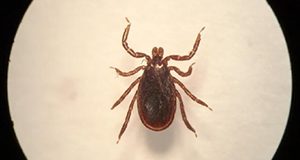Southern tick-associated rash illness (STARI) is a human tick-borne disease that occurs following the bite of Amblyomma americanum, the lone star tick, which is the most common and aggressive human-biting tick in the South, accounting for over 90% of human tick bites in the region. STARI is often described as a “Lyme-like illness” because it causes a rash like the “bulls eye” rash associated with Lyme. Other symptoms of STARI that are similar to symptoms of Lyme disease include headache, fatigue, and muscle and joint pain. Scientists know the tick vector and that some wildlife species play a role in maintaining the disease in nature, but very little else is understood about this mysterious illness. This 4-page fact sheet written by Katherine Sayler, Carisa Boyce, and Samantha Wisely and published by the Department of Wildlife Ecology and Conservation provides the basic facts we do know, the differences between STARI and Lyme disease, plus advice for tick-bite sufferers and strategies to avoid tick bites.
http://edis.ifas.ufl.edu/uw421
